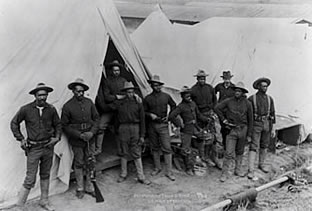
Lesson Twenty-One: African Americans in the Modern Northwest
Left: A detachment of Troop C, 9th Cavalry, from Fort Lawton in Seattle, posed before their departure to China during the Boxer Rebellion, August 10, 1900. (Special Collections, University of Washington, Social Issues Files Ca, neg. #1530. Photo by Peiser, Seattle)
People of color have generally moved to the American West for the same reason that other groups came—in search of opportunities that, they believed, would be greater in the region than elsewhere. In 1925 James Weldon Johnson, national secretary of the National Association for the Advancement of Colored People (NAACP), said during a speech in Denver: "Your West is giving the Negro a better deal than any other section of the country. I cannot attempt to analyze the reasons for this, but the fact remains that there is more opportunity for my race, and less prejudice against it in this section of the country than anywhere else in the United States."
Johnson's sentiments, while expressed in remarkably generalized form, resonated in such western cities as Los Angeles and Seattle. And studies of the African-American experience in the 20th-century urban West have tended to bear them out. Blacks have fared somewhat better in the West, compared to the other sections of the country, in the realms of political representation, economic gains, social status, and education. Such opportunities have played a role in attracting African-American migrants to the region.
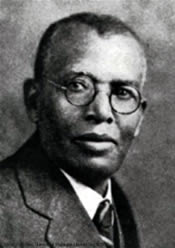
If the West and Northwest offered some improvement over opportunities in the South, Northeast, and Midwest, however, they have never permitted African Americans to achieve parity with the Anglo-American majority. Thus, blacks in the West simultaneously urged other blacks to join them in the region and pressured western whites to lower the discriminatory barriers that continued to limit their opportunities. If the region truly improved upon the rest of the country, it was a matter of limited improvement and not dramatic difference. The West and Pacific Northwest participated in the nation's racist thinking toward African Americans so that, for example, when Jim Crow laws heightened discrimination against blacks in the eastern and southern states between 1877 and 1930, they heightened discrimination in the West at the same time. African Americans in Seattle, such as the newspaperman Horace Cayton, observed, commented upon, and protested the hardening of racial lines between 1890 and 1920, even as they continued to suggest that more blacks consider moving to the Northwest. [See Horace R. Cayton, Long Old Road: An Autobiography (Seattle: University of Washington Press, 1970), esp. ch. 1 (the book is by the newspaperman's son).]
Right: Portrait of Horace Cayton, Sr. (Special Collections, University of Washington, Portrait Files. neg. #2380.) Below: African American families stayed in Roslyn after their importation as strike- breakers. (Reproduced in Mildred Tanner Andrews, Washington Women As Path Breakers. Dubuque, IA: 1989, 27. Copyright, Junior League of Tacoma. Courtesy of Ellensburg Public Library.)
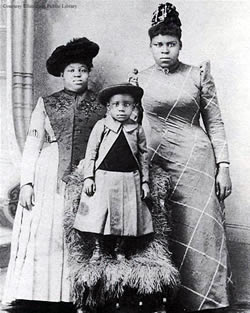
The emergence of Seattle's black community over the course of the 20th century illuminates the paradoxical fate of African Americans in the West and Northwest. [Throughout this lesson I rely heavily upon Quintard Taylor, The Forging of a Black Community (Seattle: University of Washington, 1994)]. Washington's first African-American settler, George Washington Bush, arrived during the 1840s, and by 1880 the census counted 180 in the state. Many came as homesteaders, seeking land to farm, but some went to urban areas where they encountered limited opportunities. The citizens in Seattle hardly rolled out the welcome mat, however. An ed do better if their population remained low. "There is room for only a limited number of colored people here. Overstep that liitorial in the Seattle Post-Intelligencer in 1879, which often reflected businessmen's views, warned that local blacks wouldmit and there comes a clash in which the colored man must suffer. The experience of the Chinese on this coast indicates that beyond question....The few [blacks] that are here now do vastly better than they would do if their numbers were increased a hundred fold." The P-I seemed to concede that blacks would be treated more poorly in the South, but it followed the pseudo-scientific racism of the day by stating, "The South is essentially the home of the colored man. In it he can live easier, and in a manner more in accordance with his nature and desires. Until he is stronger and better able to protect himself, it will be wiser for him to give way" (i.e., southern blacks should avoid politics and other confrontations with whites). Comparing blacks to Chinese was prescient. During the 1880s some African Americans were recruited to the state—specifically to the Northern Pacific Railroad's coal mines near Roslyn, just east of Snoqualmie Pass—by employers seeking to break strikes. Very few unions were already willing to accept blacks as members, but now white workingmen came to regard African Americans even more than before as a threat to their economic standing and labor organizations. The number of blacks in Washington kept rising, topping 1,000 in 1890, and discriminatory conditions in the state were perhaps not as bad as those elsewhere. But white hostility toward African Americans was nonetheless clear and forceful
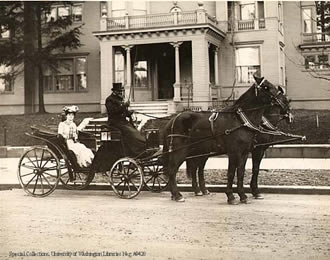
By 1900 the blacks in Washington were increasingly dwelling in cities. More than before they arrived in association with urban-based employment, working aboard ships and trains or serving in the military, and their numbers grew. The African-American population in Seattle climbed from 400 in 1900 to 2,300 in 1910, 2,900 in 1920, 3,300 in 1930, and 3,800 in 1940. The black community was not very large, compared to those in other American cities, and it was not especially prosperous. Union regulations, employment discrimination, and other factors kept the great majority of African Americans at the bottom of the economic ladder in menial and service occupations throughout the first four decades of the century. In 1910 45% of black male employees were servants, janitors, and waiters, and 84% of black female employees were domestic or personal servants; in 1940 the figures were 52% and 83%, respectively. Economic opportunities were hardly improving. Moreover, residential discrimination actually worsened during these years. In 1900 blacks lived in all fourteen of the city's wards, but in the ensuing decades discrimination by whites confined them to two primary neighborhoods—along Jackson Street near what became the International District, and along East Madison on Capitol Hill-that merged to form the Central District. African Americans found it impossible to rent or buy housing outside of these areas, and in many parts of the city they were not allowed in theaters, nightclubs, and restaurants.
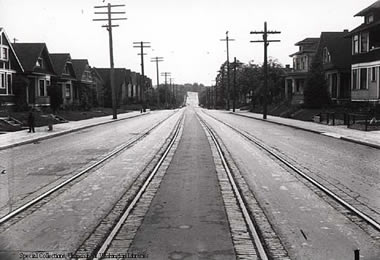 Burke Family Chauffeur, (above). Among the many living in Seattle who hired African Americans was Thomas Burke. Here his chauffeur (whose name we do not know) is shown posed with Caroline McGilvra Burke in the late 1880s. (Special Collections, University of Washington. Thomas Burke Collection #486, Box K0178, File 486/1/7. neg. #9428)
Burke Family Chauffeur, (above). Among the many living in Seattle who hired African Americans was Thomas Burke. Here his chauffeur (whose name we do not know) is shown posed with Caroline McGilvra Burke in the late 1880s. (Special Collections, University of Washington. Thomas Burke Collection #486, Box K0178, File 486/1/7. neg. #9428)
Seattle's Central District at 23rd Avenue, looking south, possibly near East Union, June 12, 1920, right. (Special Collections, University of Washington Libraries.)
Seattle was no paradise for African Americans, but it did offer opportunities not found in most other parts of the country. The black community, anchored by good schools, strong family networks, and influential churches, proved relatively cohesive, and it did not come to resemble the more troubled black ghettoes in eastern cities, at least until after the 1950s. The Central District of the early 20th century was not exclusively black; whites and people of Asian descent lived there, too. Moreover, rates of home ownership among Seattle's African Americans generally ranked among the highest in the nation. In 1910, 27% of blacks owned their own homes; in 1930, the figure was 39%, and in 1940 the figure was 29%. Only Los Angeles, among American cities, had consistently higher figures. Finally, parents were generally pleased with the city school system. Few blacks finished high school (in 1940 the average black student spent 8.4 years at school), and even fewer finished college (2.7% of blacks in 1940 were college graduates, compared to 8.3% for the entire city), because additional years of education seldom led to more economic opportunity. Yet African-American parents appreciated that the city schools offered their children chances that southern states had never provided.
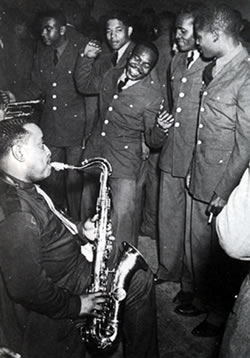
With the onset of the Second World War, life in Seattle's black community underwent considerable change. The 1940 census counted 7,000 African Americans in Washington, most of them living in Seattle. Thereafter wartime migrations brought thousands of black newcomers to the state to work in shipyards and airplane factories, to build the Hanford Engineer Works, to serve in the armed forces, and to work for government agencies. Some African Americans left after the war, yet in 1950 the state contained about 30,000 blacks, more than four times the figure from ten years before (the overall state population increased by "only" 37% over the same decade). Seattle's black population had jumped from 3,800 in 1940 to 15,700 in 1950, while Portland's grew from 1,900 to 9,500. Additionally, new or enlarged clusters of African Americans could be found in Tacoma, Bremerton, Spokane, Pasco, and other towns. In 1950 blacks comprised the largest minority group in the urban Northwest.
The recent arrivals and the so-called old settlers in black communities did not always see eye to eye. The newcomers had less education and fewer skills, and old settlers worried that they might upset the racial accommodation reached between blacks and whites in pre-war Seattle. For their part, the recent arrivals saw the old timers as snobbish and too accommodating. Urban overcrowding tended to exacerbate tensions, for patterns of racial segregation were not suspended during the war. In 1944 the Central District contained 5,000 people in housing that had served 3,700 residents in 1940. Yet as the largest black community in the Northwest it was also home to newcomer and old settler, and a refuge where visiting black soldiers could feel comfortable. Moreover, despite their differences both old settlers and new arrivals found common cause in resisting prejudice and common interests in the African-American culture that flourished in their community. [On this subject, see Paul De Barros, Jackson Street After Hours: The Roots of Jazz in Seattle (Seattle, Sasquatch Books, 1993).]
Seattle's Jackson Street after hours (above) provided entertainment for soldiers out for a night on the town, above. (Reproduced in Paul De Barros, Jackson Street After Hours: The Roots of Jazz in Seattle. Seattle, Sasquatch Books, 1993. p. 90. Photo by Al Smith.)
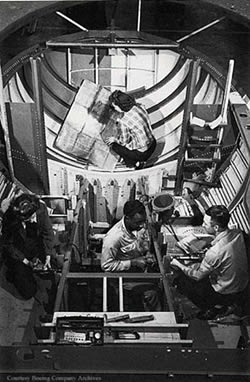
The war opened employment opportunities for blacks in Seattle that had not existed before. Some came at the expense of people of Japanese descent, who had been evacuated. [Quintard Taylor explores the pre-war relationship between African Americans and people of Japanese descent in "Blacks and Asians in a White City: Japanese Americans and African Americans in Seattle, 1890-1940," Western Historical Quarterly 22 (Nov. 1991): 401-29. Post-war racial tensions between blacks and Nikkei are documented in John Okada's fine novel No-No Boy (Seattle: University of Washington Press, 1979).] More opportunities came because of the city's mobilization for defense production. The shipyards in particular hired African Americans, in large part because one union in the yards was relatively receptive to black members. About 6.8% of Seattle's 60,000 shipyard workers in 1945 were African American (and the Kaiser shipyards in greater Portland likely employed even more blacks). The second largest employer of African Americans was the federal government 0.4% of Seattle's 18,900 federal employees were black. The Boeing Airplane Company, on the other hand, hired proportionally fewer African Americans, in part because the International Association of Machinists resisted the idea until pressured into accepting it by federal officials. "We resent that the war situation has been used to alter an old established custom" in regard to prohibiting employment of blacks, one union official explained, "and do not feel it will be helpful to war production." Once employed at Boeing, African Americans encountered segregated lunchrooms and bathrooms, and second-class status in unions. They could pay dues but not vote or accrue meaningful seniority.
The end of the war brought substantial adjustments for African Americans. Some defense-industry employment dried up, but the economy of the city rebounded after 1946. Wage rates in Seattle after the war remained relatively high for African Americans at 53% above the national average in 1948. And compared to before the war blacks found better jobs available to them, in industry and government. They also engaged more successfully in civil-rights activism after 1945, partly because they felt that their sacrifices during the war had proven that they were first-class citizens. Blacks and white supporters of civil rights lobbied during the late 1940s for a state fair employment practices law to reduce discrimination in the workplace. The Washington Federation of Labor, continuing organized labor's animosity toward African Americans, opposed the legislation for five years and successfully diluted it, yet the bill passed in 1949. In 1950 the Central District elected Seattle's first black representative to the state legislature. These successes contributed to the city's civil rights movement of the 1950s, 1960s, and 1970s.

Above: African American Workers at Boeing during WWII. Boeing publicity photographs during World War II showed African Americans as a part of the construction crews. (Reproduced in Quintard Taylor, The Forging of a Black Community. Seattle, 1994. Plates following p. 178. Photo courtesy of Boeing Company Archives.) Right: An integrated classroom. By 1950 in Seattle there were African American women teaching in integrated classrooms. (Special Collections, University of Washington, Seattle Urban League Records. Reproduced in Quintard Taylor, The Forging of a Black Community. Seattle, 1994. Plates following p. 178.)
Although Portland's African-American population had also grown during the 1940s, that city was regarded as less having fewer opportunities than Seattle. The wartime shipbuilding industry there had attracted many African Americans; Portland may have had as many as 21,000 blacks in 1945. But two years later the total had dropped to 12,000, and by 1950 is was down to 9,500. Portland was reputed to be a less tolerant city for African Americans; it also possessed a smaller nucleus for the black community. Perhaps more importantly, Portland did not retain as many defense-related jobs in the Cold-War period as Seattle did. Of the 4,500 African Americans in the Portland labor force in 1947, only one-third were employed. It is no wonder that the city's black population actually shrunk in the immediate post-war period. [See Quintard Taylor, "The Great Migration: The Afro-American Communities of Seattle and Portland during the 1940s," Arizona and the West 23 (Summer 1981): 109-126.]
Seattle may have seemed somewhat more attractive than Portland, yet it was hardly perfect. Blacks had made some gains during wartime, but discrimination and poverty persisted. It remained very difficult, for example, for qualified black buyers to purchase housing outside of the Central District. In 1948 one local realtor was expelled from a national organization for violating their "code of ethics." He had sold a home in a white neighborhood to black buyers, and therefore violated the rule stating that "A realtor should never be instrumental in introducing into a neighborhood a character of property or occupancy which will clearly be detrimental to property values." Seattle's black community arguably faced somewhat fewer problems and somewhat less discrimination than its counterparts in other American cities, but the city and its inhabitants had no cause for complacency regarding race relations. The protests, tensions, and anxieties of the 1950s-1990s—concerning such matters as school desegregation and busing, economic and social inequality, housing, police harassment, and political representation—demonstrated that Seattle basically faced the same racial problems as the rest of the nation.
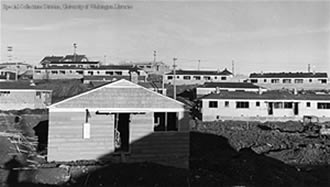 The following figures from 1989-1990 attest to the effects of persistent racial inequities. In Seattle, 30% of whites and Asian Americans had college degrees, but only 11.5% of blacks did. Fifteen percent of Seattle's blacks possessed only an elementary-school education. Blacks accounted for 22.5% of the 53,000 Seattleites living below the poverty line, even though they amounted to less than 10% of the city's population; by contrast, only 9.1% of whites fell below the poverty line. Blacks made up 7.9% of Seattle's adult population but 14.5% of its unemployed. And across the state, black inmates accounted for 20.6% of the prison population but only 3% of Washington residents. These figures do not deny the existence of a sizeable and growing black "middle class," but they do suggest that for all its "opportunities" the Pacific Northwest has not come close to "solving" on a regional level the racial inequities that have characterized the 20th-century United States.
The following figures from 1989-1990 attest to the effects of persistent racial inequities. In Seattle, 30% of whites and Asian Americans had college degrees, but only 11.5% of blacks did. Fifteen percent of Seattle's blacks possessed only an elementary-school education. Blacks accounted for 22.5% of the 53,000 Seattleites living below the poverty line, even though they amounted to less than 10% of the city's population; by contrast, only 9.1% of whites fell below the poverty line. Blacks made up 7.9% of Seattle's adult population but 14.5% of its unemployed. And across the state, black inmates accounted for 20.6% of the prison population but only 3% of Washington residents. These figures do not deny the existence of a sizeable and growing black "middle class," but they do suggest that for all its "opportunities" the Pacific Northwest has not come close to "solving" on a regional level the racial inequities that have characterized the 20th-century United States.
Rainier Vista, March 1942 (above). African American residency in public housing was as problematic as home ownership. Jesse Epstein, director of the Seattle Housing Authority insisted, successfully, on integrated housing in West Seattle, Sand Point, Holly Park, and Rainier Vista. In the words of Quintard Taylor in The Forging of a Black Community (Seattle, 1994), "those residents, already apprehensive over public housing for the white poor, including a disproportionate number of southern-born war workers, now feared an influx of Southern black migrants, into their neighborhoods." (Special Collections, University of Washington.)
| Course Home | Previous Lesson | Next Lesson |